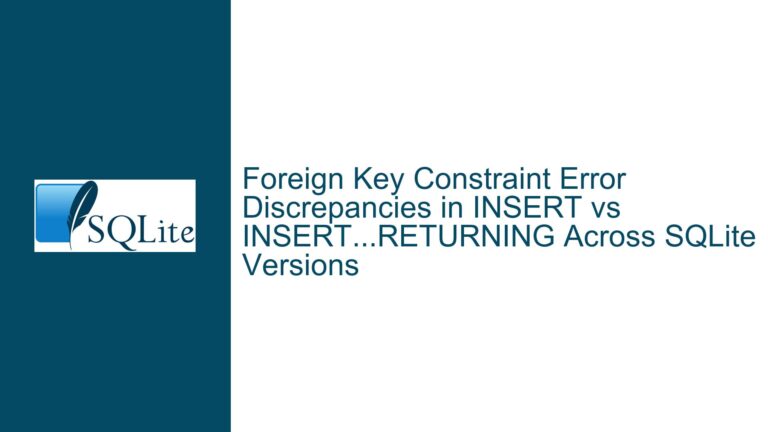Floating-Point Conversion Failures in SQLite on i686 Architecture with R-Tree Enabled
Issue Overview: Floating-Point Precision and Conversion Errors on i686 Architecture
The core issue revolves around the failure of the atof1 test in SQLite 3.38.0 when building on the i686 architecture with the --enable-rtree option enabled. The atof1 test is designed to validate the correctness of floating-point conversions, specifically ensuring that conversions between floating-point numbers and their string representations are accurate and reversible. On the i686 architecture, this test fails, indicating that the conversions are not behaving as expected. This failure is isolated to the i686 architecture, as other architectures (x86_64, aarch64, ppc64le, s390x) do not exhibit this issue.
The problem manifests in two specific scenarios:
- Float-to-String-to-Float Conversion: A floating-point number is converted to a string and then back to a floating-point number, but the final value does not match the original.
- String-to-Float Conversion: A string representation of a floating-point number is converted to a floating-point value, but the result is incorrect.
The issue is particularly concerning because it suggests a potential flaw in how SQLite handles floating-point arithmetic on 32-bit x86 systems when the R-Tree module is enabled. The R-Tree module, which is used for spatial indexing, may be influencing the behavior of floating-point operations, though the exact mechanism is not immediately clear.
Possible Causes: Architecture-Specific Floating-Point Behavior and R-Tree Interaction
The failure of the atof1 test on i686 architecture can be attributed to several potential causes, each of which must be carefully examined to understand the root of the problem.
Floating-Point Precision Differences on i686: The i686 architecture, being a 32-bit system, has different floating-point handling characteristics compared to 64-bit architectures. The
tcl_platform(pointerSize)andtcl_platform(wordSize)values from the Tcl output indicate that the i686 system uses 4-byte pointers and words, which may affect how floating-point numbers are stored and processed. The precision of floating-point operations on 32-bit systems can differ due to the use of x87 FPU instructions, which have historically caused issues with intermediate precision and rounding.R-Tree Module Influence on Floating-Point Operations: The
--enable-rtreeoption enables the R-Tree module, which is used for spatial indexing. The R-Tree module may introduce additional floating-point operations or alter the behavior of existing ones. For example, spatial calculations often involve geometric computations that rely heavily on floating-point arithmetic. If the R-Tree module is not properly accounting for the differences in floating-point handling on 32-bit systems, it could lead to the observed conversion errors.Compiler and Optimization Flags: The build environment for Fedora Rawhide may include specific compiler flags or optimizations that affect floating-point behavior. For instance, certain optimization flags might alter the way floating-point operations are performed, leading to inconsistencies in precision. The absence of such flags in other architectures could explain why the issue is isolated to i686.
Endianness and Byte Order: Although the
tcl_platform(byteOrder)output indicates that the system is little-endian (which is typical for x86 architectures), it is still worth considering whether byte order plays a role in the floating-point conversion process. However, this is less likely to be the primary cause, as endianness issues typically manifest in more obvious ways, such as incorrect integer values.Tcl Interpreter Behavior: The
atof1test relies on the Tcl interpreter for its operations. Differences in how the Tcl interpreter handles floating-point numbers on i686 could contribute to the issue. For example, the Tcl interpreter might use different internal representations or conversion routines on 32-bit systems, leading to discrepancies in the test results.
Troubleshooting Steps, Solutions & Fixes: Diagnosing and Resolving Floating-Point Conversion Issues
To address the floating-point conversion failures on i686 architecture, a systematic approach is required. The following steps outline the process for diagnosing and resolving the issue.
Verify Floating-Point Behavior on i686: Begin by isolating the floating-point operations in the
atof1test to determine whether the issue lies within SQLite or the underlying system. This can be done by writing a minimal C program that performs the same floating-point conversions as theatof1test. The program should convert a floating-point number to a string and back, then compare the result to the original value. If the minimal program exhibits the same issue, the problem is likely related to the system’s floating-point handling rather than SQLite itself.Examine the R-Tree Module’s Floating-Point Usage: Review the source code of the R-Tree module to identify any floating-point operations that might be affected by 32-bit architecture differences. Pay particular attention to geometric calculations, such as distance computations and bounding box intersections, which often involve floating-point arithmetic. If problematic areas are found, consider modifying the code to use more robust floating-point handling techniques, such as explicit rounding or the use of higher-precision intermediate values.
Adjust Compiler Flags and Optimization Settings: Experiment with different compiler flags to see if they affect the outcome of the
atof1test. For example, disabling certain optimizations (e.g.,-ffast-math) might resolve the issue by preventing the compiler from making unsafe assumptions about floating-point operations. Additionally, consider enabling strict floating-point mode (-frounding-math) to ensure consistent behavior across architectures.Implement Architecture-Specific Workarounds: If the issue is confirmed to be specific to i686, consider implementing architecture-specific workarounds in SQLite. For example, the
atof1test could be modified to account for the reduced precision of 32-bit floating-point operations by allowing a small tolerance when comparing floating-point values. Alternatively, the R-Tree module could be adjusted to use integer arithmetic for certain calculations, reducing reliance on floating-point operations.Collaborate with the Tcl Community: Since the
atof1test relies on the Tcl interpreter, it may be beneficial to consult with the Tcl community to determine whether the observed behavior is expected on i686 systems. If the Tcl interpreter is found to be contributing to the issue, consider updating to a newer version of Tcl or applying patches to address the problem.Document the Issue and Provide Guidance: If the issue cannot be resolved immediately, document it thoroughly and provide guidance for users who may encounter similar problems. For example, include a note in the SQLite documentation explaining that the
atof1test may fail on i686 systems with the R-Tree module enabled, and recommend disabling the test or using a 64-bit architecture if precise floating-point conversions are required.Long-Term Solutions: For a more permanent fix, consider enhancing SQLite’s floating-point handling to be more robust across different architectures. This could involve using standardized libraries for floating-point operations, such as the IEEE 754-compliant functions provided by the C standard library, or implementing custom routines that ensure consistent behavior regardless of the underlying architecture.
By following these steps, the floating-point conversion issues on i686 architecture can be systematically diagnosed and resolved, ensuring that SQLite remains reliable and consistent across all supported platforms.






